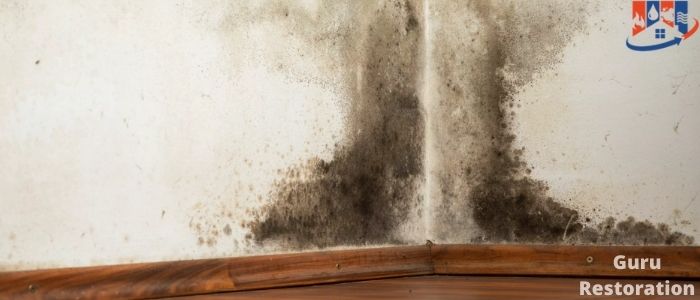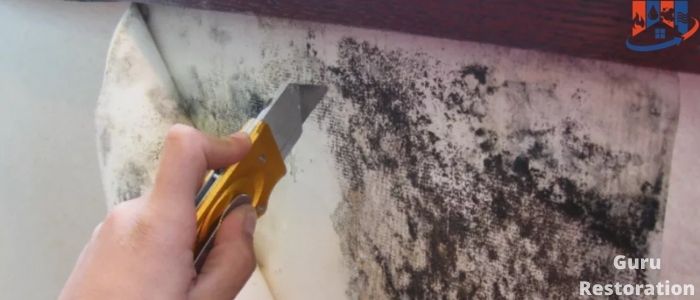Mold is a type of fungus that grows in humid conditions and multiplies through microscopic seeds, so-called mold spores. Under the influence of harmful forms of mold, even healthy people may experience respiratory problems, skin irritation, and headaches.
If you or one of your family members have asthma or allergies, identifying the mold in your home helps to maintain health and, in some cases, even save someone’s life.

Signs That Mold Has Appeared In Your House
Experienced specialists can confirm or deny mold presence indoors or outdoors. If necessary, they will examine the air inside the apartment or house, and check the walls and other surfaces for mold growth. Mold that is out of sight, as a rule, is the most serious health threat.
How health is affected by living in a room where mold is growing:
- the increase in respiratory diseases;
- skin inflammations;
- permanent irritation of mucous membranes;
- tiredness, nausea, general malaise;
- mental disorders;
- immune suppression;
- allergic reactions;
- headache, dizziness, and coordination disorders;
- memory impairment and ability to concentrate;
- feverish states;
- autoimmune disorders;
- irritability, anxiety, and depression.
Causes Of Mold On Walls
The causes of mold on the walls are the following very serious malfunctions in the functioning of your home.
| Drip moisture of condensate | If not properly adjusted double-glazed windows, the glasses collect moisture, and on the sealer seal – mold. It is so inconspicuous that people do not see it. But if you hold on to the seal with a cotton swab, it will remain a black mark. Modern sealants that are used to repair the kitchen, – a favorable environment for the emergence of mold. |
| Leaking pipes | Now everywhere are laid not metal, but plastic pipes. They are durable, but only if made of high-quality material. Hot water pipes, which go to the batteries, are laid under the cement tie. If their joints are fixed with violations, there is a source of mold in the apartment, which shows itself, of course, not immediately. Often, it is produced under the wallpaper, because wallpaper glue is the ideal food for her. |
| Floods | Among the reasons may be lack of caution when using water supply and sewerage, force majeure situations such as heavy rains and floods. If such an unpleasantness has occurred, time and attention should be given to carefully ventilating the room to normalize the humidity level as soon as possible. You should wipe the water as soon as possible, dry the walls, ceilings, floors, textiles, and upholstered furniture, but this is not a guarantee that the mold and fungus will be deprived of the chance of life. |
| Poor ventilation | This often leads to high humidity, which is the most favorable environment for the fungus. Be sure to keep an eye on the ventilation of the bathroom, children’s room, kitchen, and other rooms in the house. This will help to keep the moisture balance normal. |
How To Detect Mold In The Walls Of Your Home
To identify mold, there are a number of measures that you can take yourself to identify unwanted elements in your home:
- visual mold inspection;
- physical mold examination;
- internal mold inspection.
Visual mold inspection
Visual inspection is usually the easiest and best way to find out if there is mold in your walls. First of all, check out the utility rooms, bathrooms, and kitchens.
Check for wet areas and watermarks
Examine the entire wall for cracks or peeling, bulges, discoloration, or strange stains. Usually, the mold looks like blurred stains, and on walls and furniture, it may look like distinct stains, black-green, brown, or white. These are the usual places near the bottom of the walls (due to gravity).
Check the areas of the walls near the sanitary ware, as these places are usually leaks.
If you have a leaking roof, then carefully inspect the joints between the ceiling and the walls in all rooms. If the wallpaper is behind in these places, check also behind the wallpaper.

Room smell
If you smell mildew and must, this is an indicator of mold growth. The stronger the smell, the higher the growth rate. Sometimes it may be the only indicator of mold. If the odor is only present when the air conditioner or oven is on, the mold may be in the ducts or in the installations themselves.
Physical mold examination
Physical examination will require you to move your hands along the wall. You can press a little if you see wet areas or watermarks.
Try to find any moisture by walking your hand along the wall. Mildew needs moisture for growth, so if moisture accumulates in the wall, but no discoloration is visible, it can only mean that the mildew is formed inside the wall. However, after a while, the mold on the inside of the wall will try to break through to the outside.
Internal mold inspection
The last step to discover the mold inside your walls is to look inside. To avoid damaging the wall, I recommend using existing holes in the wall (e.g. a socket) or making a small test cut that will allow you to use the boring.
If you are using an opening from a socket, take precautions not to electrocute yourself.
You can also use a boroscope. You can also use a boroscope to check the space between walls. Drill a small hole in the wall where it was wet recently, gently insert the end of the fiber optic cable into the hole. The monitor will show a picture of the space between the walls, slip the cable into the hole, and see if there are any signs of mold.
But, as mentioned earlier, it is mold professionals who will be able to identify it accurately.
Our professionals are equipped with a number of special devices, which you do not have access to, to accurately identify the affected areas, as well as to recognize a particular type of mold (white mold or black mold).
In conclusion, I would like to note that monitoring the occurrence of mold inside and outside your walls is not a complicated process, but it works for the long term and will help to avoid problems with your home and the health of your family in the future.

